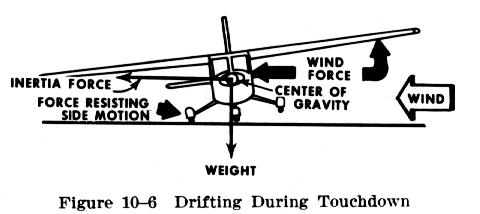
At times the pilot may correct for wind drift by crabbing on the final approach. If the roundout and touchdown are made while the airplane is drifting or in a crab, it will contact the ground while moving sideways. This will impose extreme side loads on the landing gear, and if severe enough, may cause structural failure.
The most effective method to prevent drift in primary training aircraft is the "wing low method." This technique keeps the longitudinal axis of the airplane aligned with both the runway and the direction of motion throughout the approach and touchdown.
There are three factors that will cause the longitudinal axis and the direction of motion to be misaligned during touchdown; drifting, crabbing, or a combination of both.
If the pilot has not taken adequate corrective action to avoid drift during a crosswind landing, the main wheels' tire treads offer resistance to the airplane's sideward movement in respect to the ground. Consequently, any sidewise velocity of the airplane is abruptly decelerated, with the result that the inertia force is as shown in Fig. 10-6. This creates a moment around the main wheel when it contacts the ground, tending to overturn or tip the airplane. If the windward wingtip is raised by the action of this moment, all the weight and shock of landing will be borne by one main wheel. This could cause structural damage.

Not only are the same factors present that are attempting to raise a wing, but the crosswind is also acting on the fuselage surface behind the main wheels tending to yaw (weathervane) the airplane into the wind. This often results in a ground loop